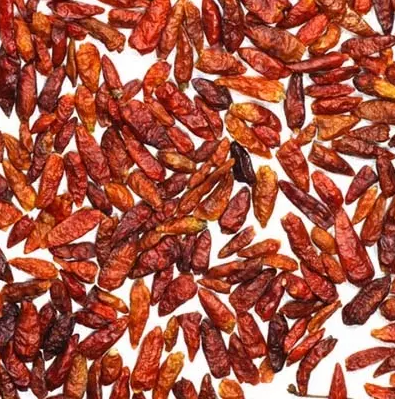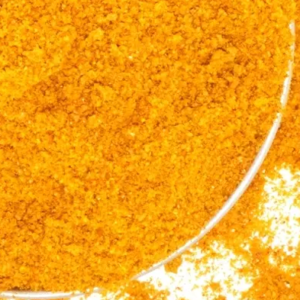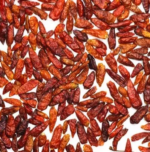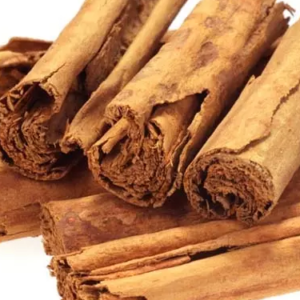How to Use African Birdseye Chiles
African Bird’s Eye Chiles are commonly used to make peri-peri sauce, a vinegar and lemon sauce that showcases the heat and flavor of this pepper. Vinegar loves these peppers, so pickle them for a salty-sour bite, or mix with mild peppers for a pepper relish. Because of the high heat of this chile, it’s usually used as a complementary ingredient rather than a main one. Put anywhere you’d like a shot of heat; rehydrate and mince to add to salsa, or mix into a marinade for chicken. Add to chicken dishes, hot sauces, soups, and stews.
| Ingredients | African Bird’s Eye Chiles |
| Also Called | Birds eye chili, dried bird eye chili, or birds eye chilli |
| Recommended Uses | Chicken dishes, peri peri sauce, soups, and stews |
| Flavor Profile | A clean flavor with undertones of dry hay and a nice bite |
| Scoville Heat Units | 100,000 – 225,000 SHU |
| Species | Capsicum frutescens |
| Cuisine | African |
| How To Store | Airtight container in a cool, dark place |
| Shelf Life | 1-2 years |
| Country of Origin | Uganda |
| Dietary Preferences | Gluten Free, Kosher, Non-GMO |
What Are African Bird’s Eye Chiles
The tiny African Bird’s Eye Chile makes a big impact for such a little berry, also known by their Swahili name pili-pili (or peri-peri, or piri-piri depending on the influences of dialect and translation).
The Bird’s Eye Chile, specifically the variety from Uganda, is believed by many to be the hottest chile that is not a member of the legendary Capsicum chinense species. Due to these potent heat levels most of these African chiles are harvested and processed for commercial use as a pepper extract.
There are numerous wild chiles that have the word bird in their names so distinguishing among them can be a bit difficult. Most of the undomesticated bird peppers come from the four species Capsicum annuum, Capsicum baccatum, Capsicum chinense, and Capsicum frutescens.
African Bird’s Eye Chiles are typically between ½” and 1″ in length and taper to a blunt point. The immature fruit is green in color and fully ripens to a bright red.
History of African Chiles
Given that north of the Sahara region in Africa the Arab countries have long been more closely tied to the Mediterranean region than with the rest of Africa, it is highly likely that this was the region that chile peppers would have first been introduced in Africa. With the Strait of Gibraltar separating North Africa from the Iberian Peninsula by only a few miles the likelihood of chile peppers moving south from the ancient port city of Cadiz in Spain to the Moroccan port of Tangier seems highly probable.
The spread of chile peppers throughout the rest of Africa is not likely to have come from this early introduction into North Africa by the Arabs but is owed to the Portuguese. Between 1460 and 1488 (before Columbus had sailed to the Americas) the Portuguese had become very familiar with the western regions of Africa. With the discovery of the new world it was the Portuguese who would have introduced Brazilian grown Capsicum annuum and Capsicum chinense into first western and later eastern African Portuguese controlled ports between 1493 and 1533. Chiles would have been grown by Portuguese settlers in small home gardens in these settlements.
While the Portuguese were responsible for their introduction into the ports of Africa they were not responsible for their spread. In much the same manner that chiles spread north into Central America from South America it was due to the birds. African birds would eat the bright red fruits on the chile plants and carry them inland spreading the seeds and leading to the naturalization of various chile plants throughout the region. Chile plants thrived in this environment and were naturally cross-bred into numerous varieties.
In 1816 Sir Robert Townsend Farquhar of the East India Company listed both Capsicum annuum and Capsicum frutescens in his catalogue of exotic plants cultivated in Mauritius (an island just east of Madagascar) with Capsicum frutescens being naturalized. The English botanist Sir William Hooker wrote of Capsicum annuum being a common cultivated plant in Sierra Leone by 1849.
Cultivation of African Bird’s Eye Chiles
As a perennial plant, the African Bird’s Eye Chile is productive for 2 to 3 years but has been known to produce fruit for up to 5 years.
These chiles thrive in organic-rich, light loamy, well-drained soils, the optimum growing temperature is between 68°F and 86°F and temperatures below 60°F and above 90°F will prevent the fruit from fully developing. African Bird’s Eye peppers do best with between 24 and 47 inches of rain or irrigation per year. Too much rain will lead to rotting and leaf dropping and too little rainfall will lead to early dropping of flowers and aborting of fruit.
These chile plants will reach a height of 18″ to 48″. Typical of the Capsicum frutescens species, African Bird’s Eye Chiles grow partly pointed towards the sky. The plant will yield between 21 and 36 ounces of fresh chile peppers per plant per year. The peppers are ready to be harvested when they turn red to purple, usually about 90-120 days after planting. Because the size of the chiles is so small harvesting is a very laborious process.
Harvested chiles are not dried directly in the sun as they are prone to damage (burned flesh) from the sun. Depending on the weather African Bird’s Eye Chiles take 3-4 days to dry completely. At this point the chiles are graded and separated prior to packaging.
Where Are These African Bird’s Eye Chiles From
Uganda.
What Do Bird’s Eye Chiles Taste Like
A clean flavor with undertones of dry hay and a nice bite. These chiles lack the flavor complexity of some of the more popular chiles.
How Hot Is the African Bird’s Eye Chile
We consider African Bird’s Eye Chiles to be a crazy hot chile at 100,000-225,000 SHU.








Reviews
There are no reviews yet.